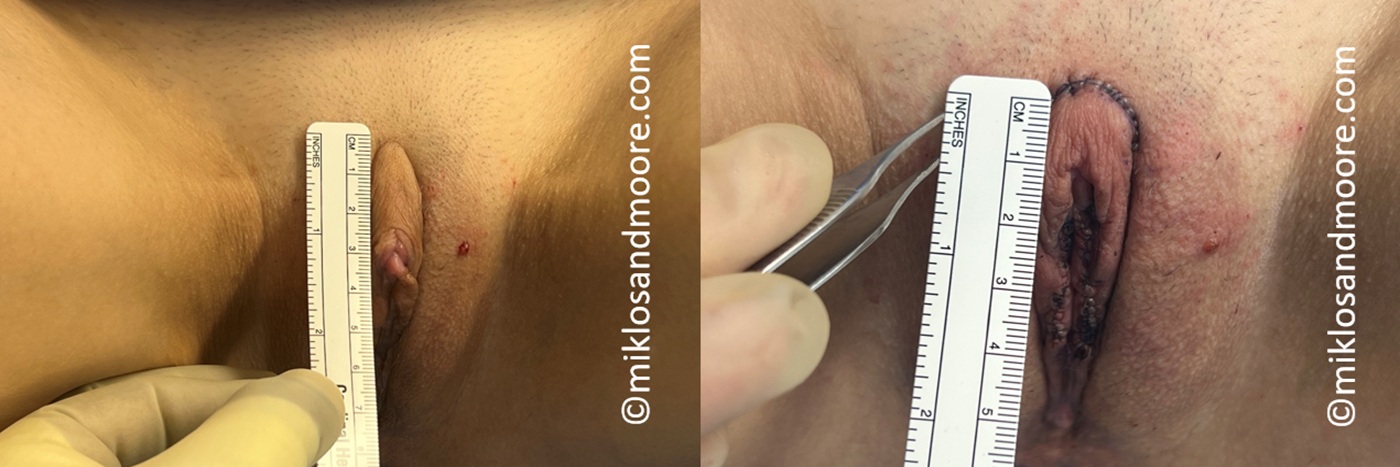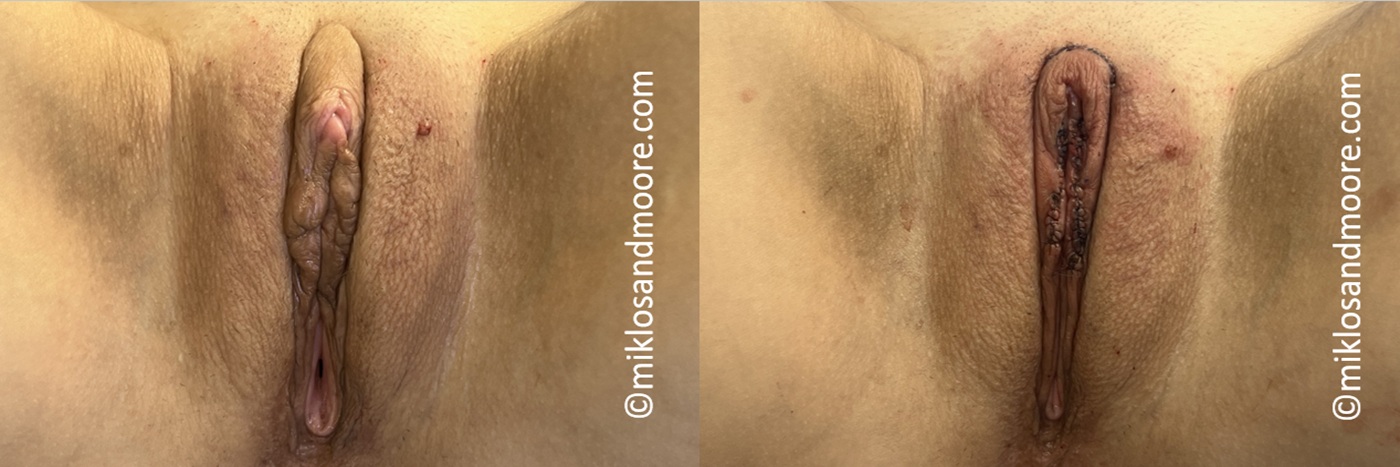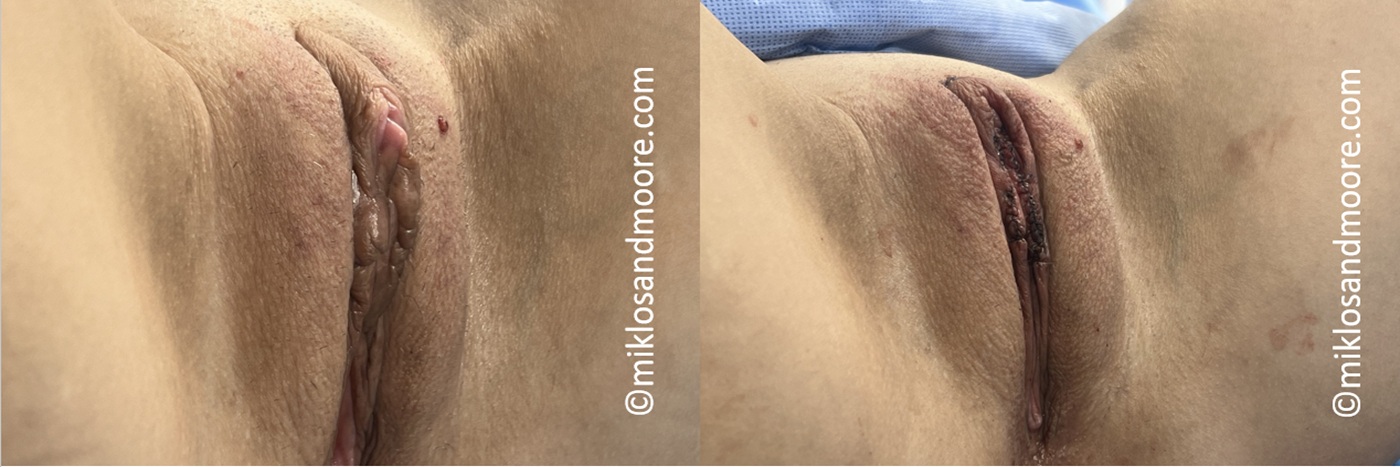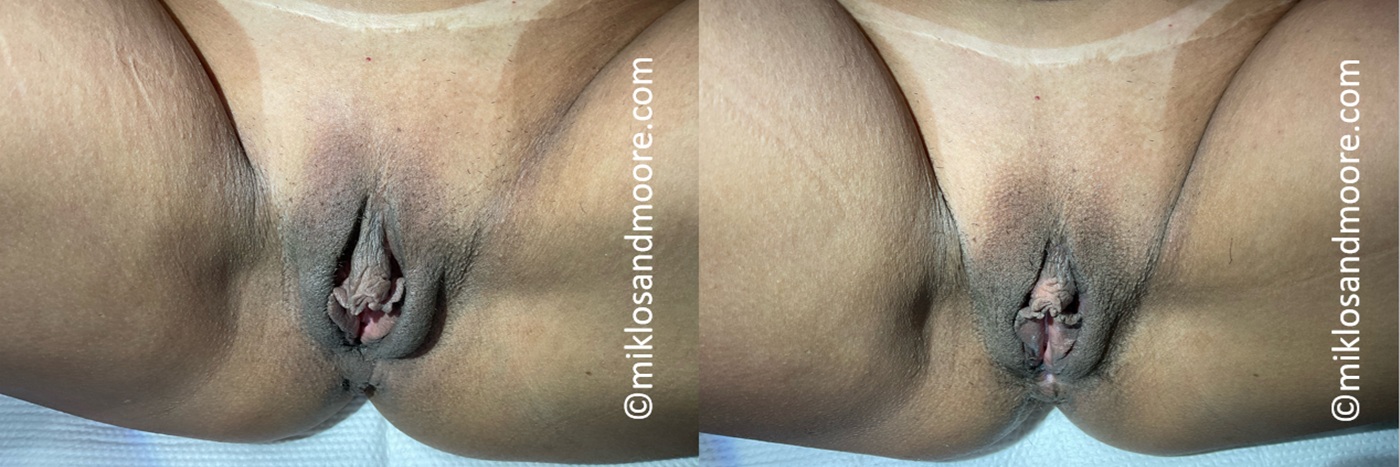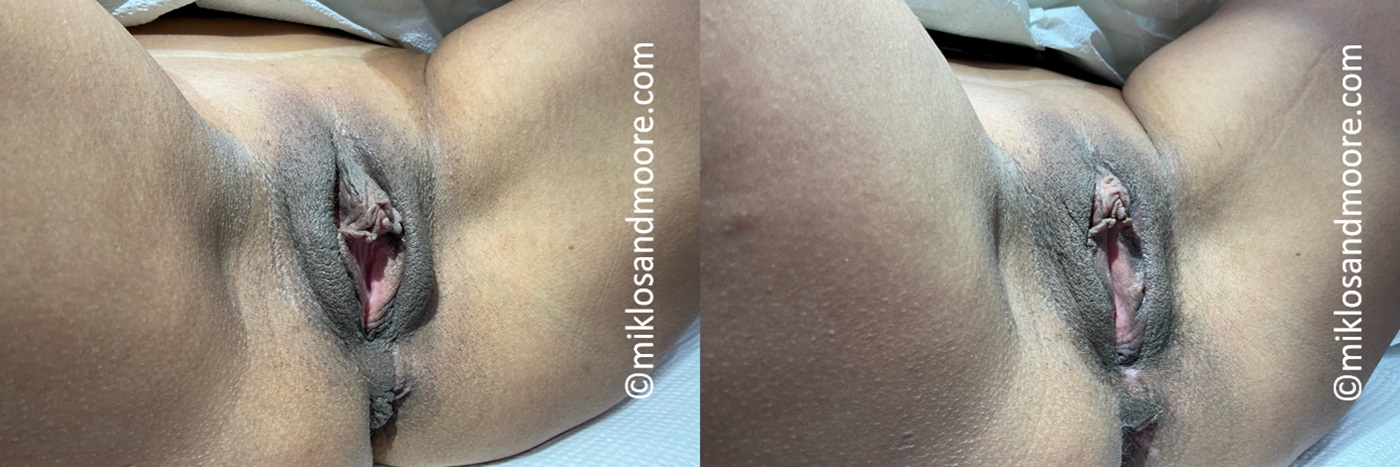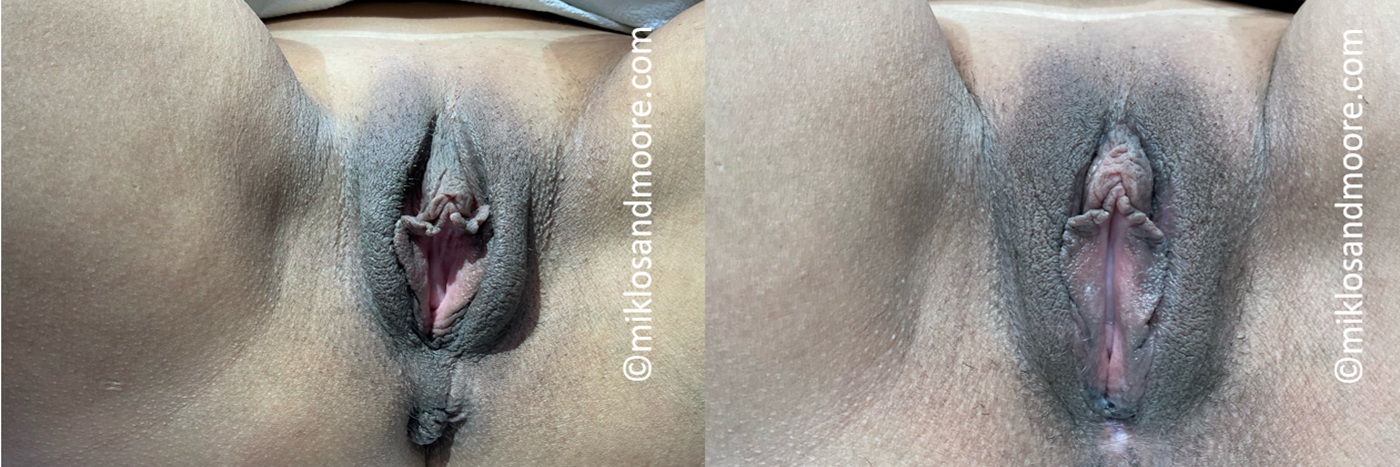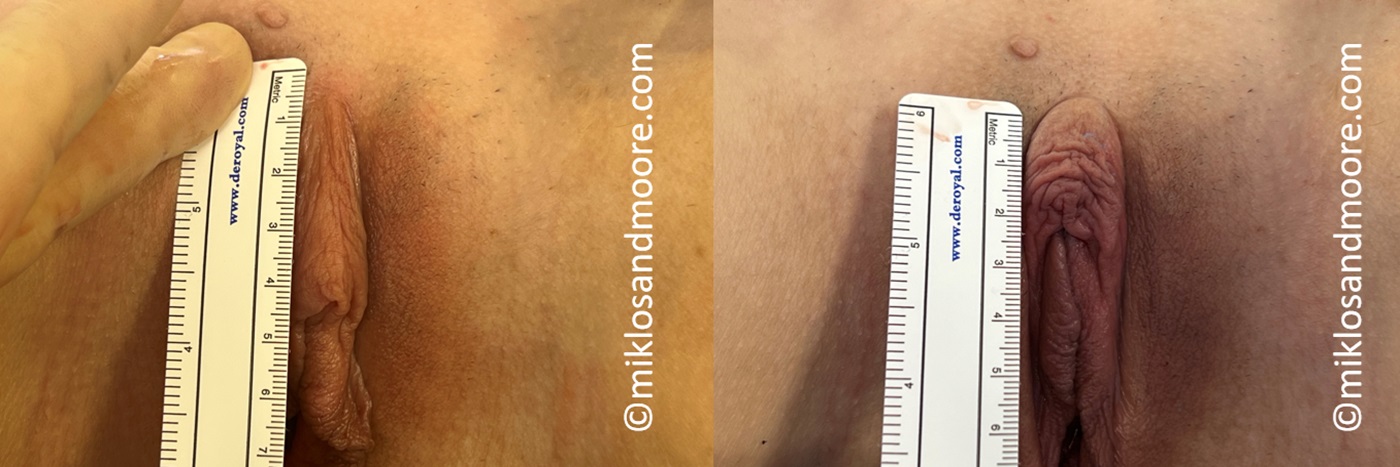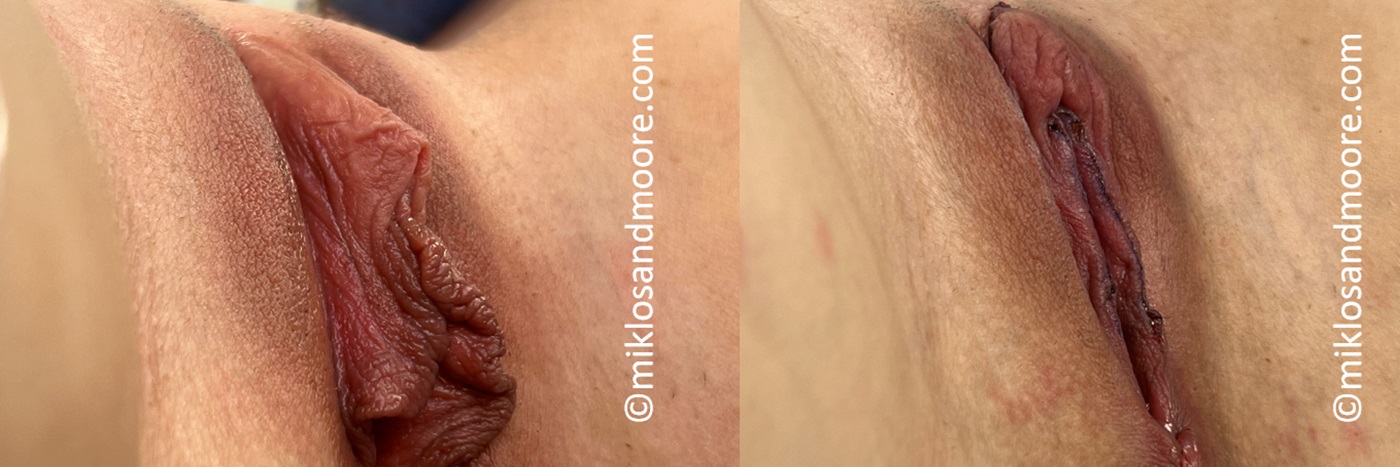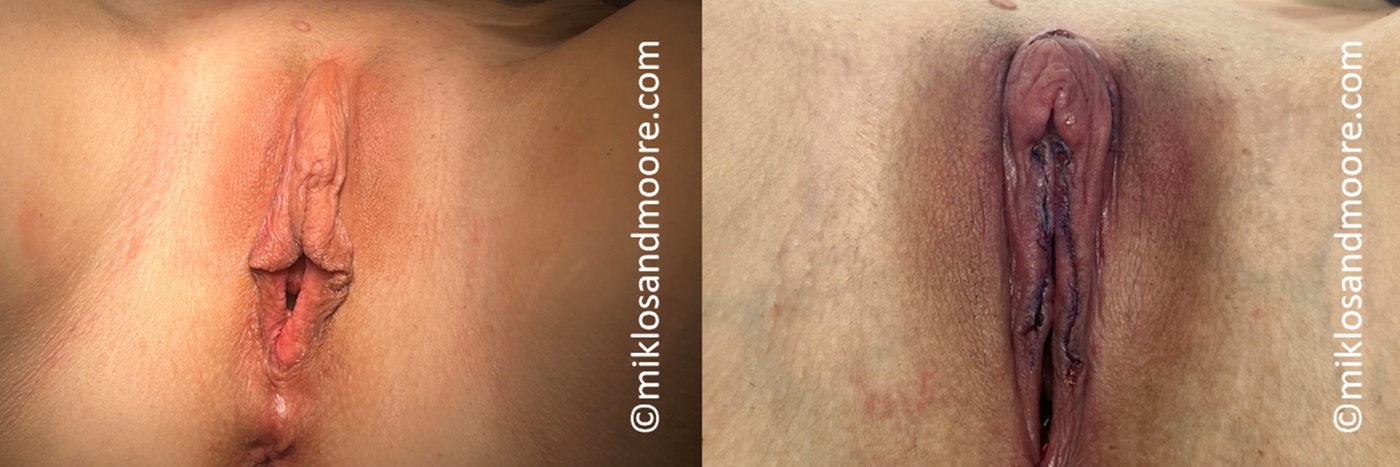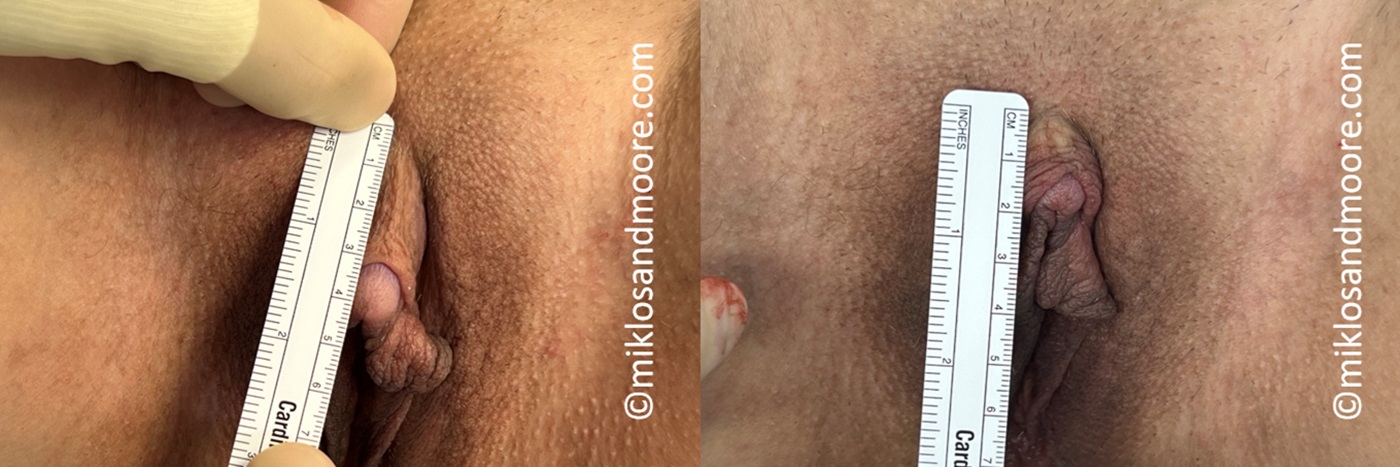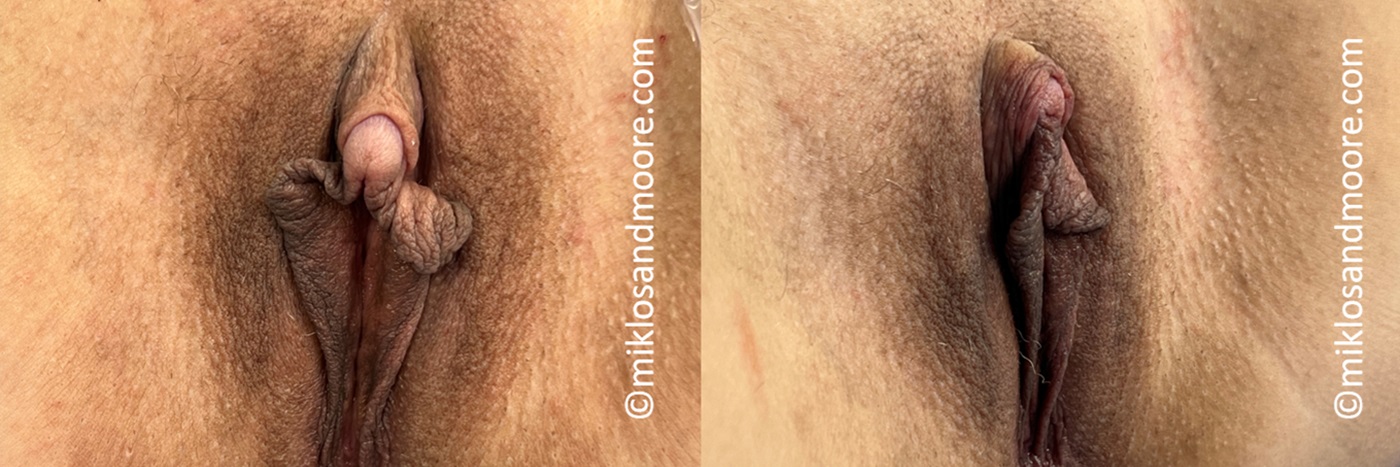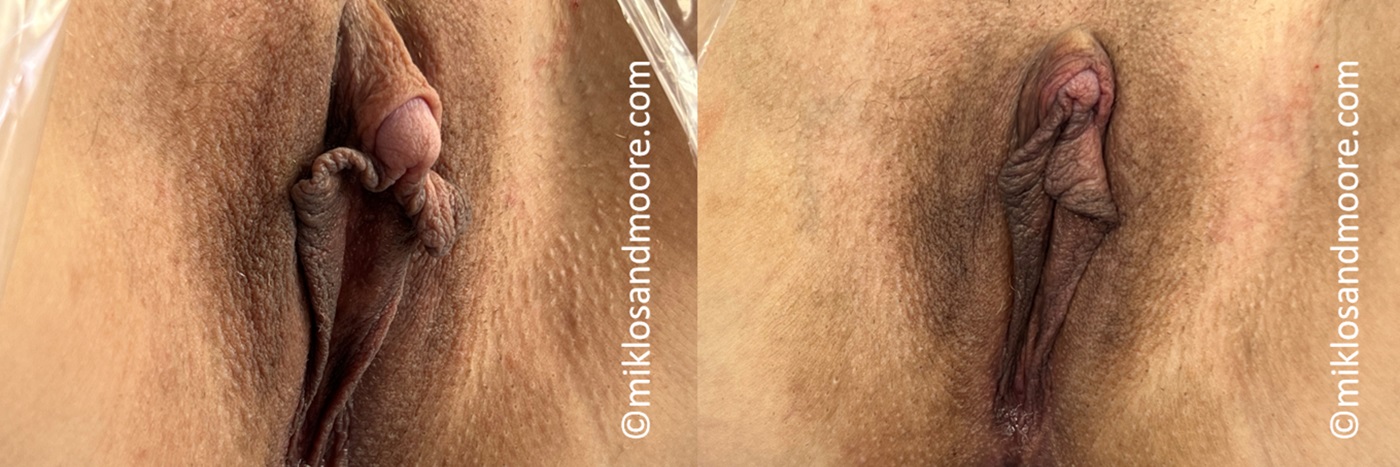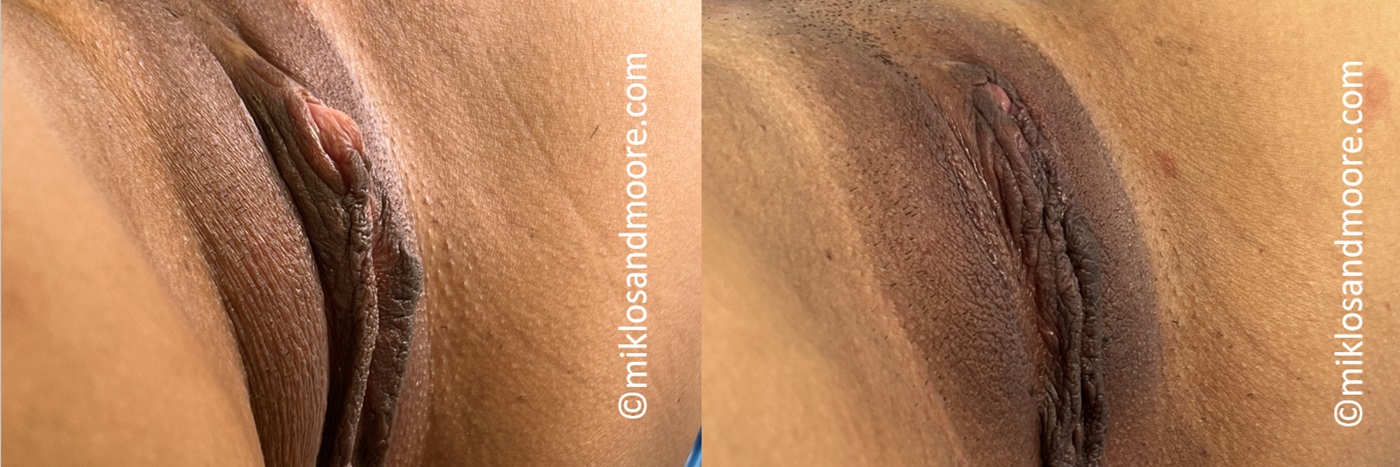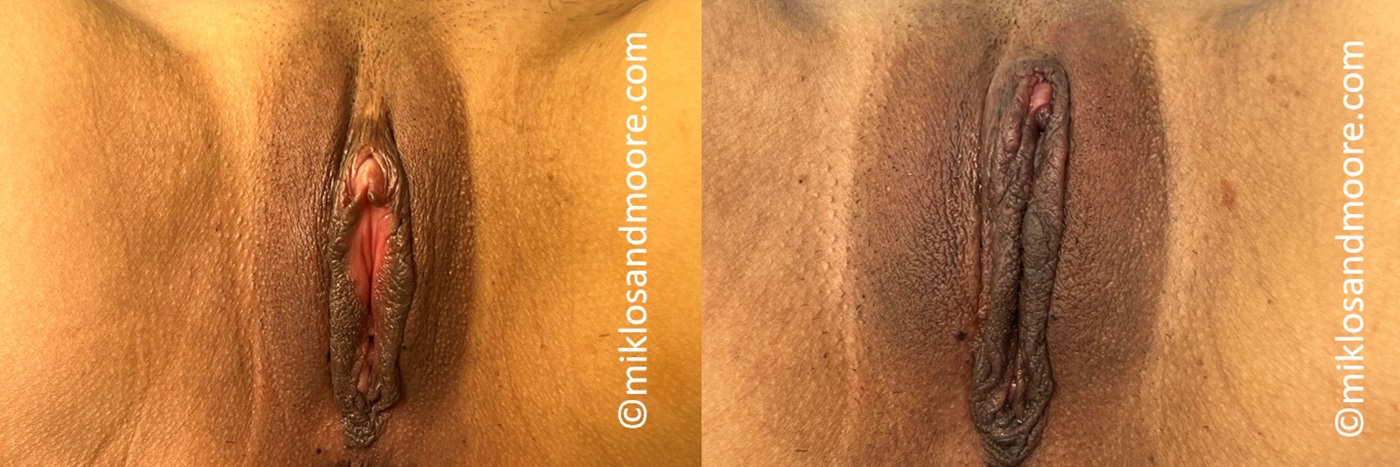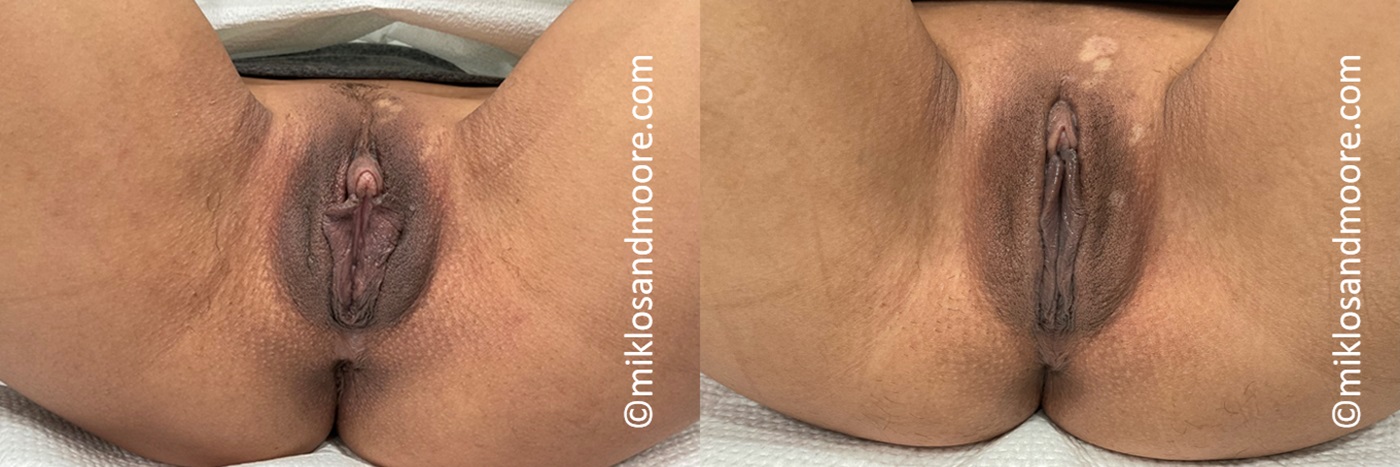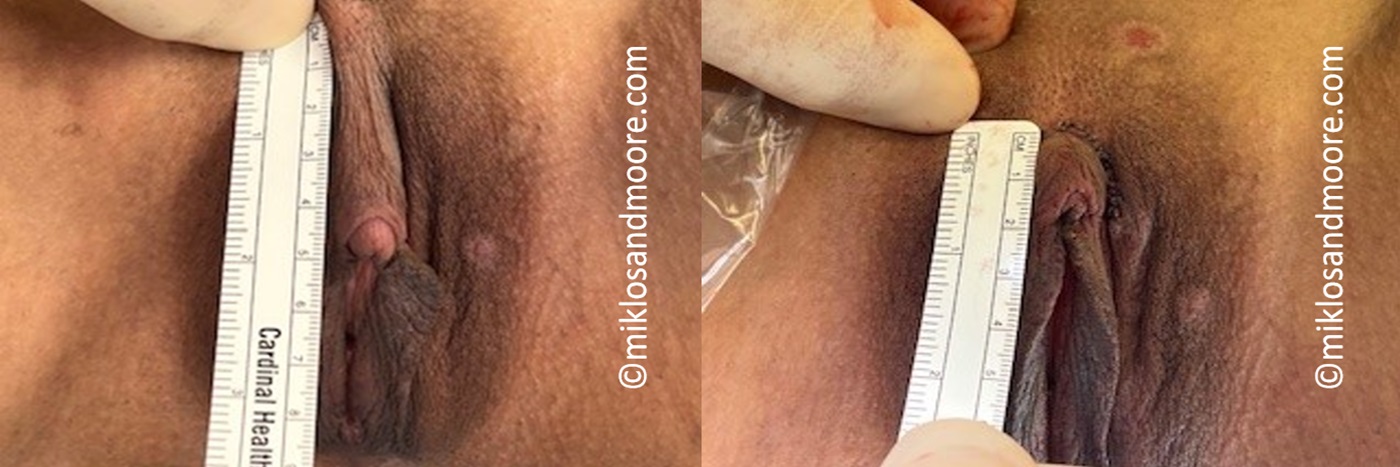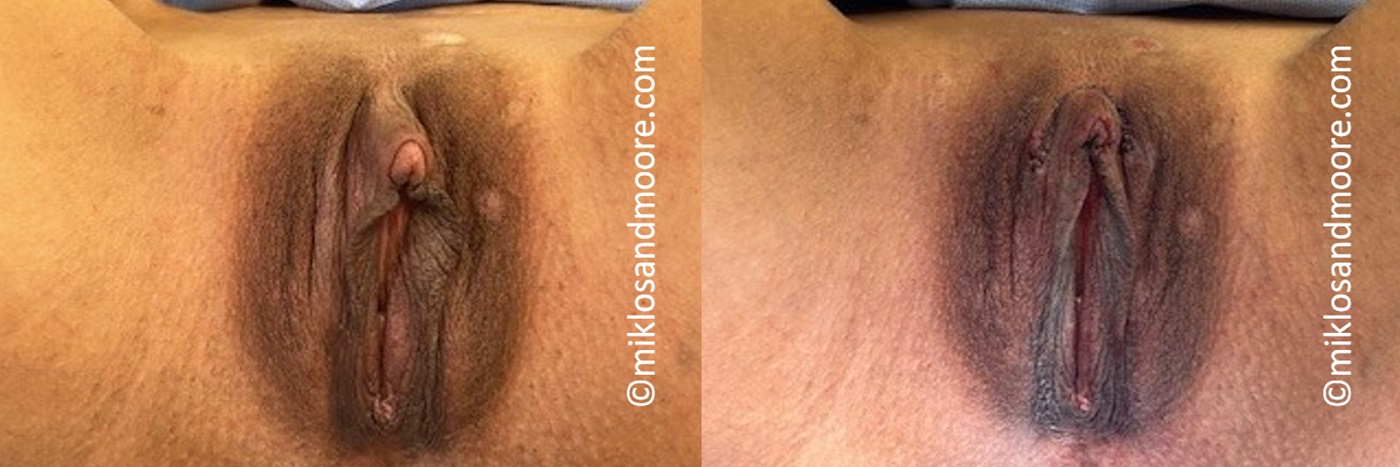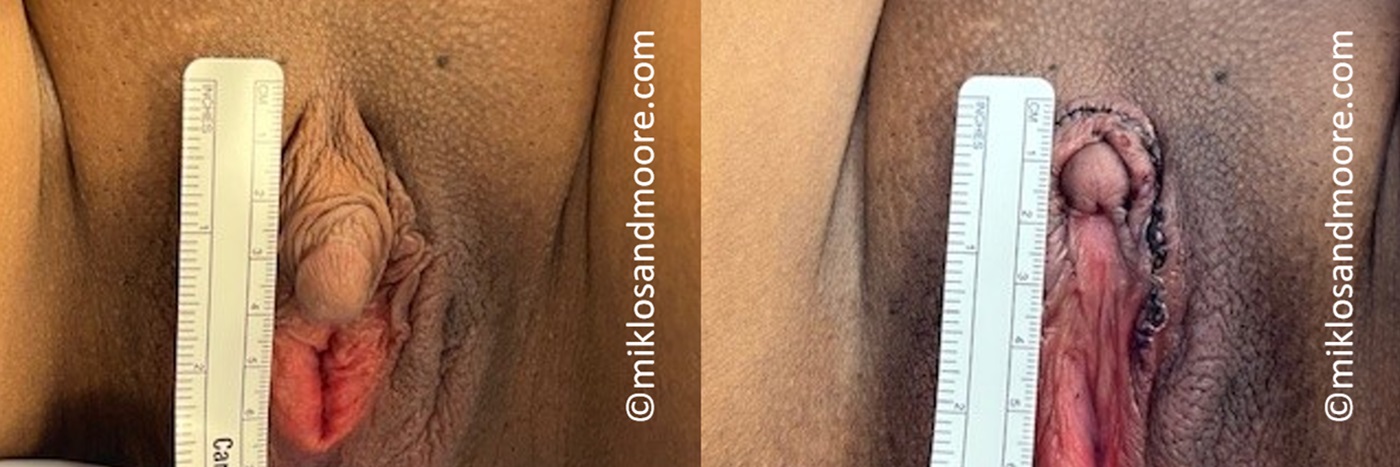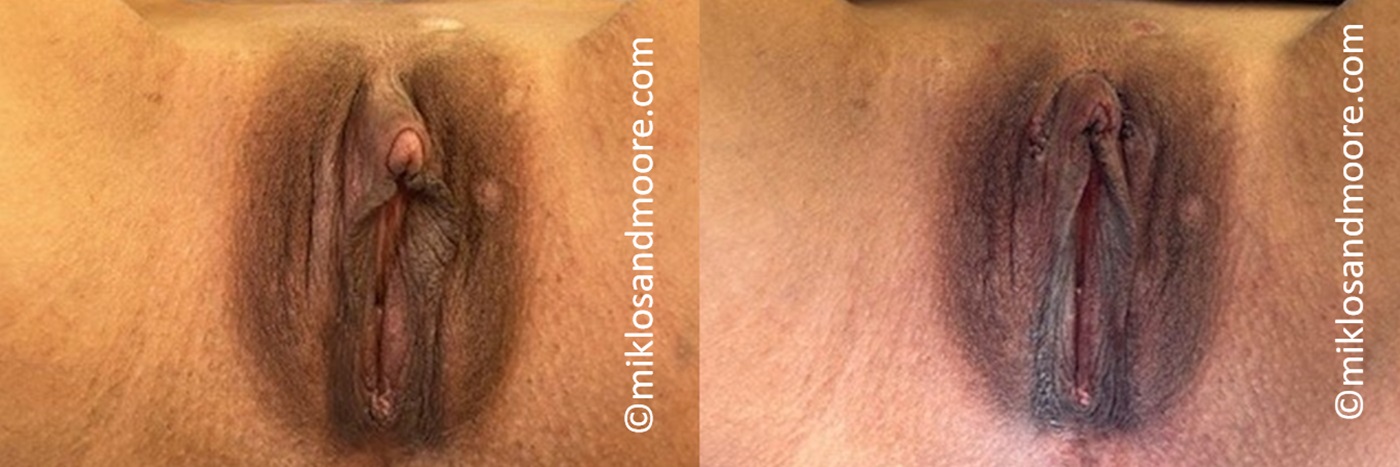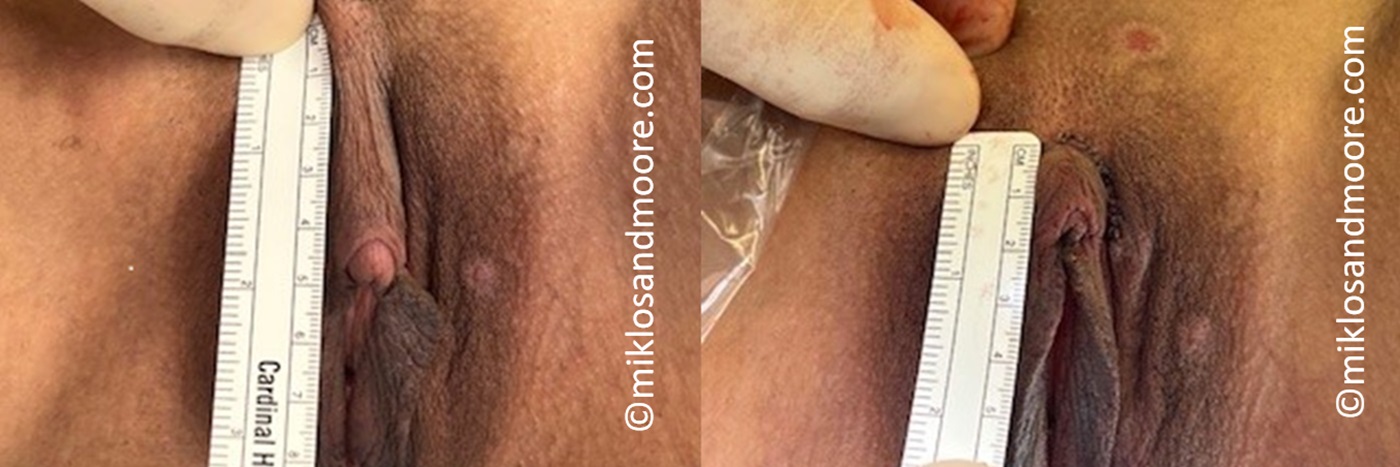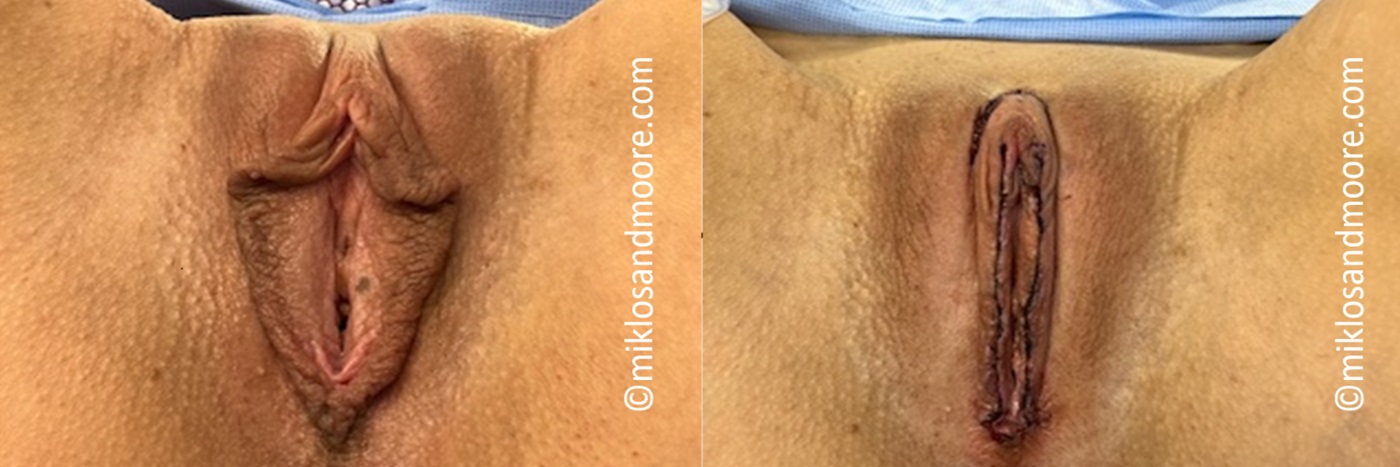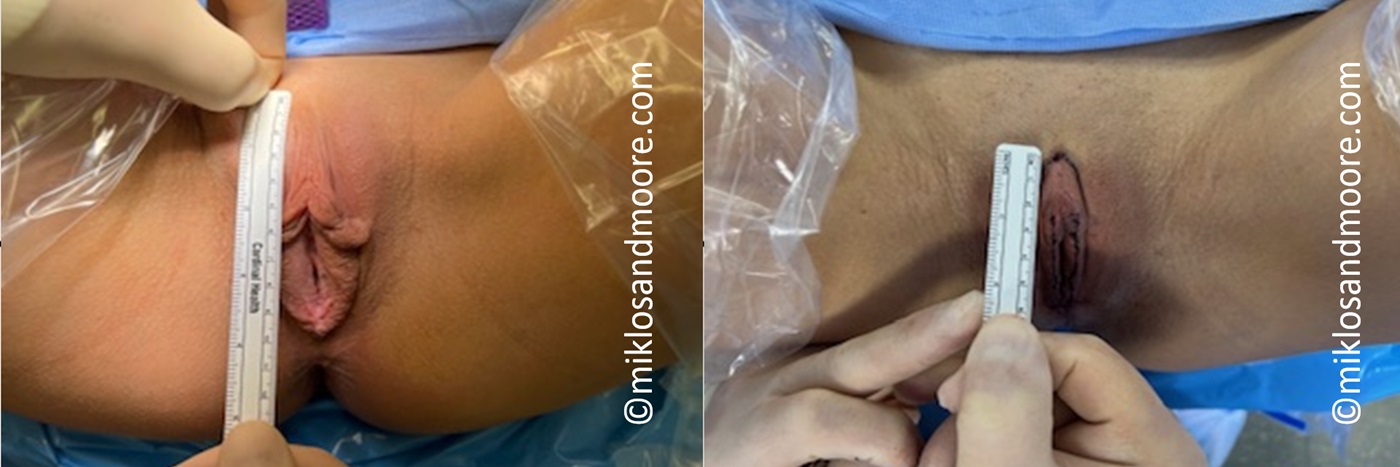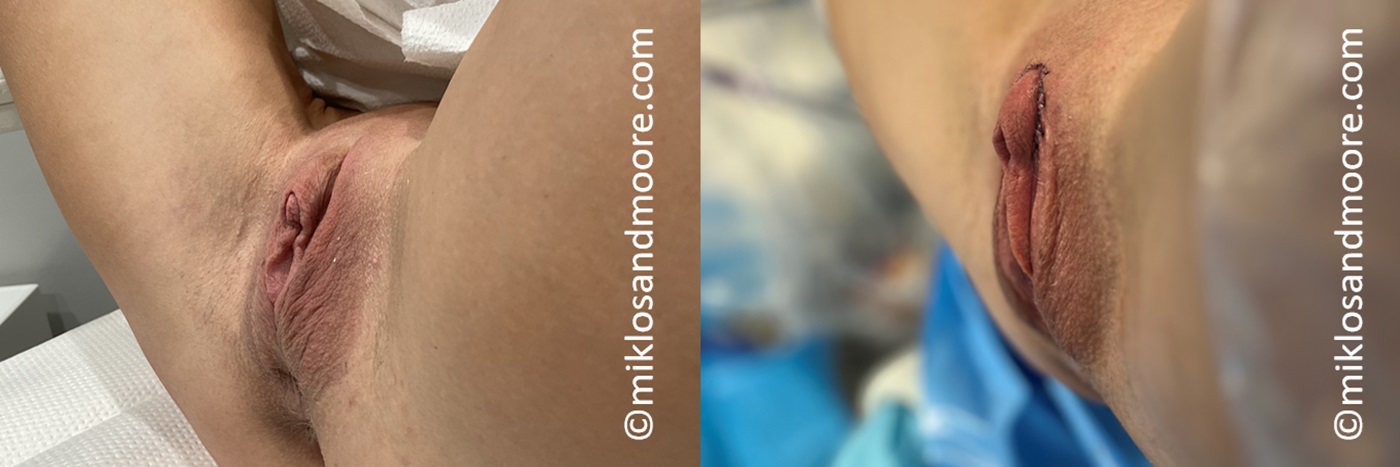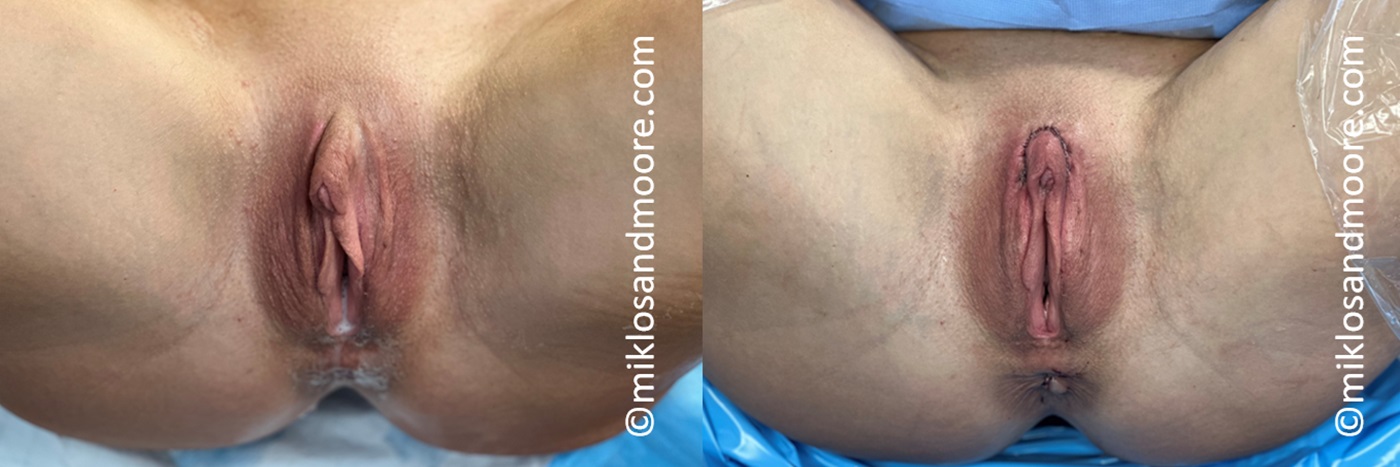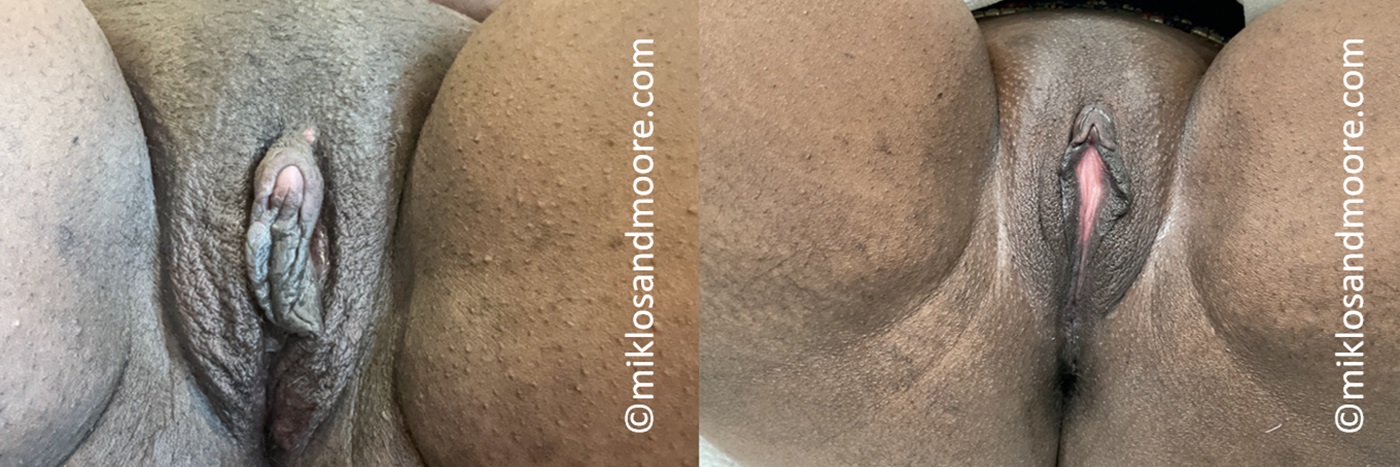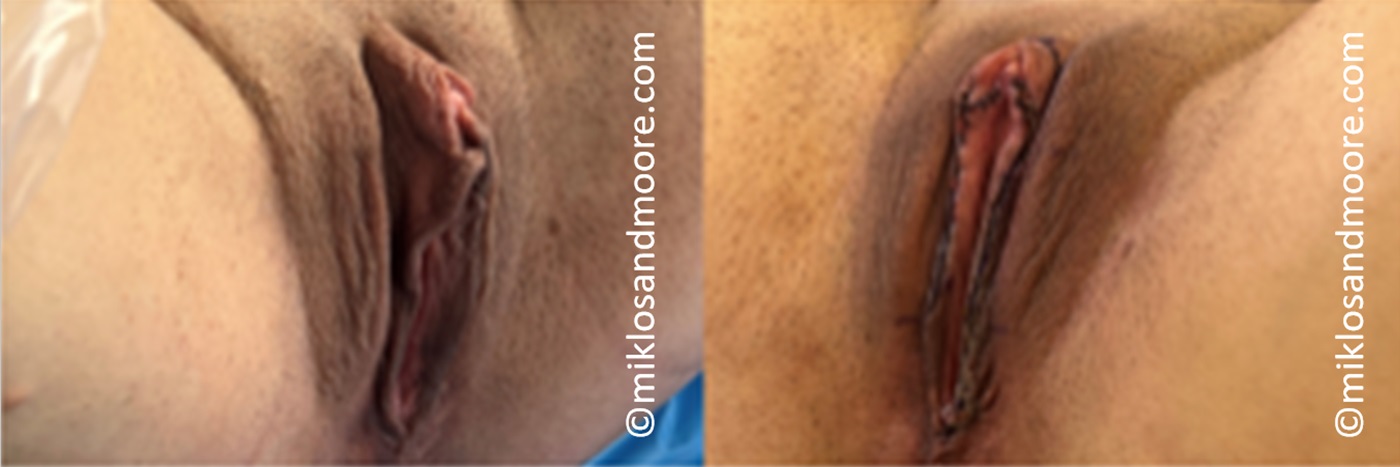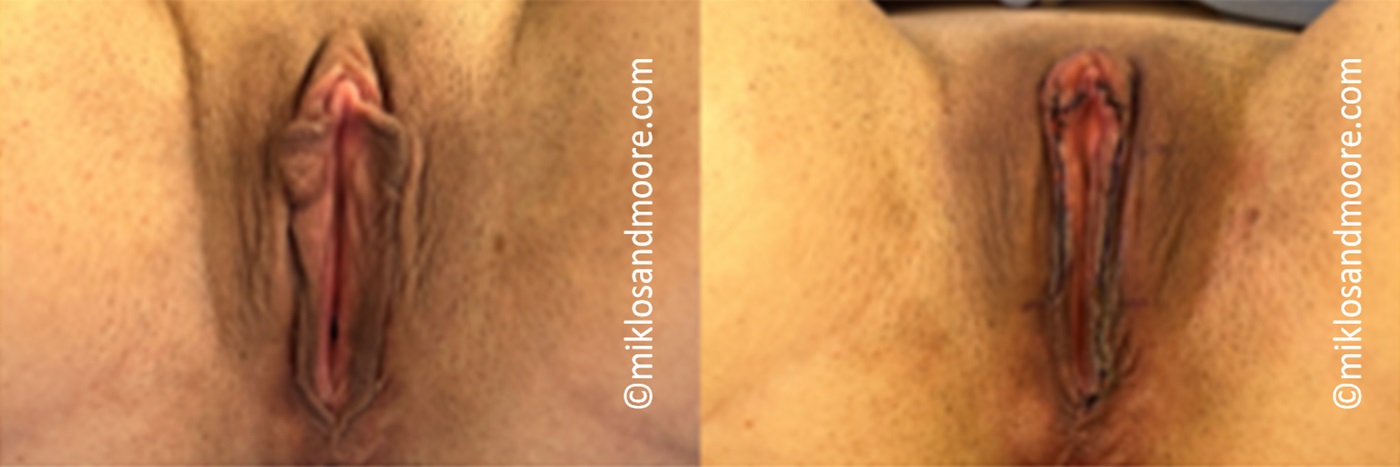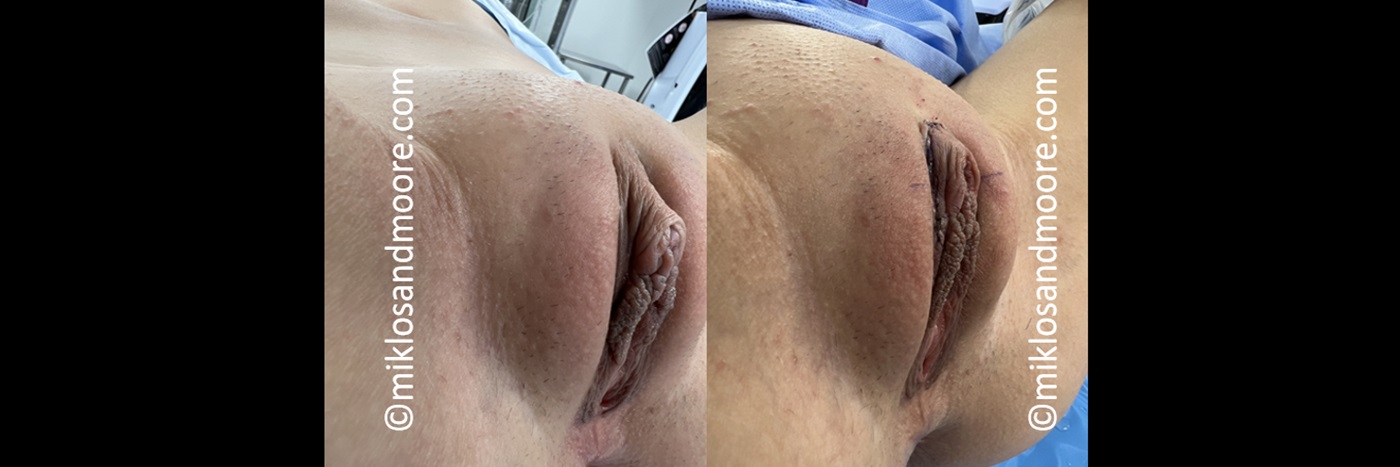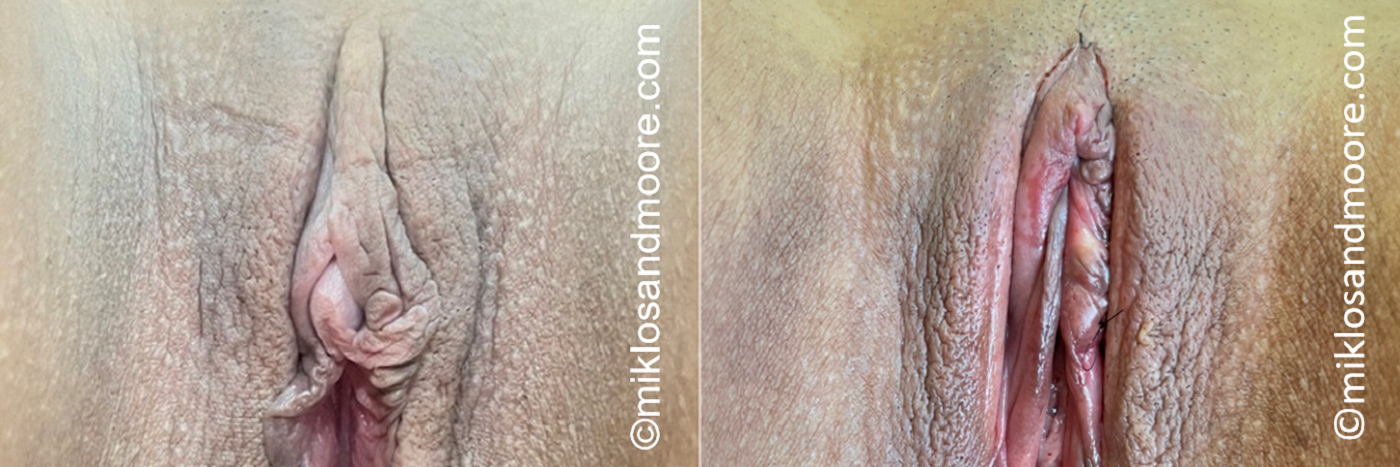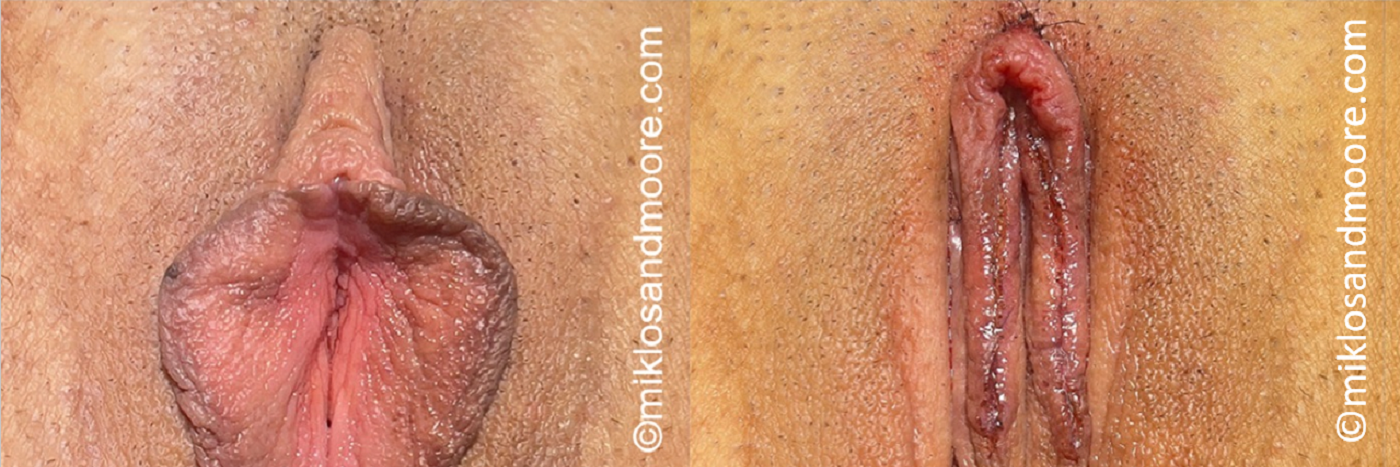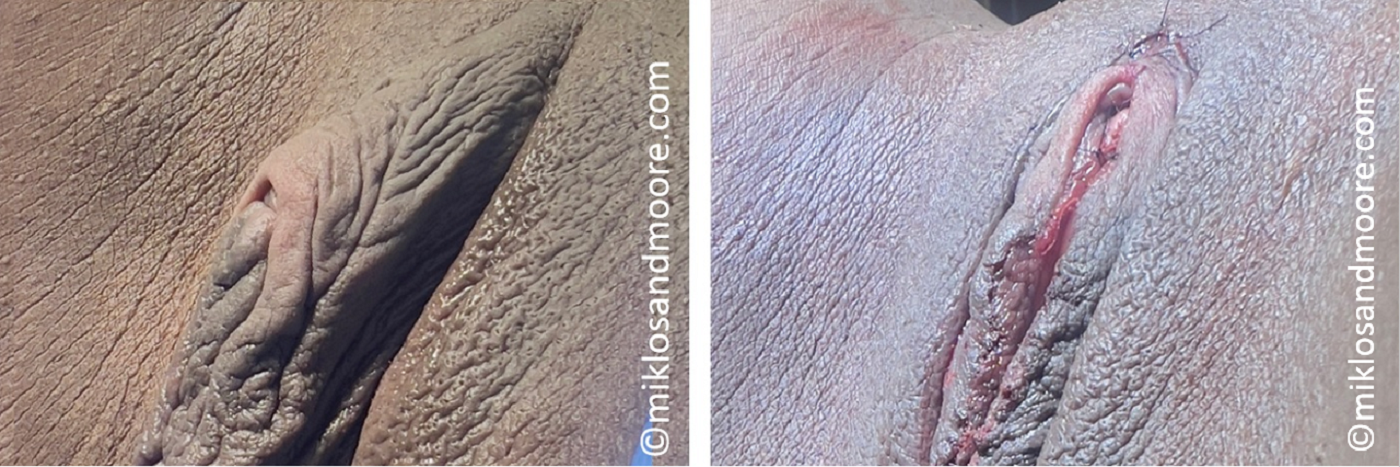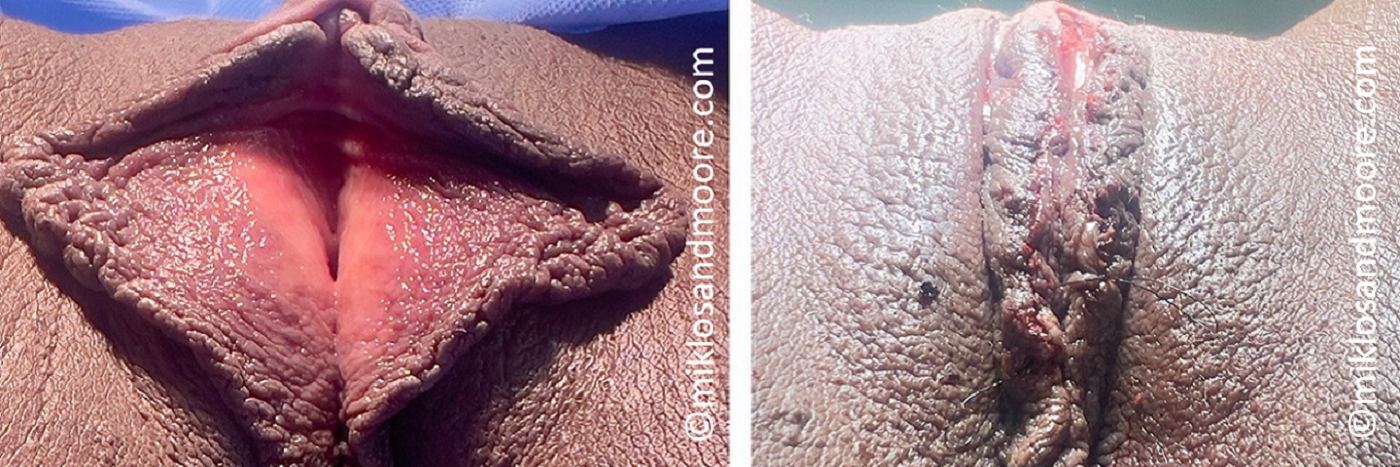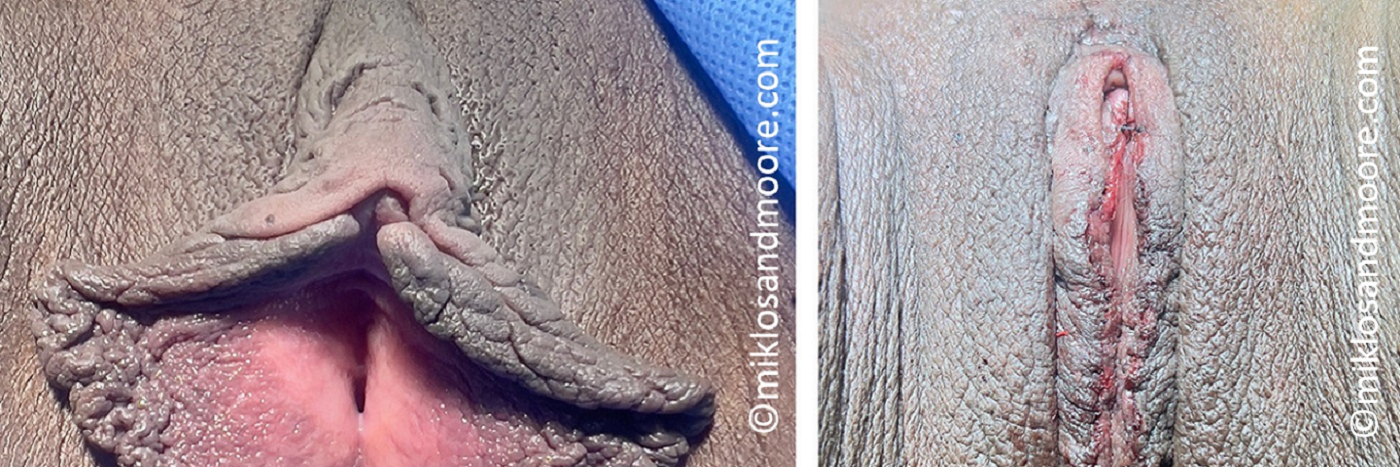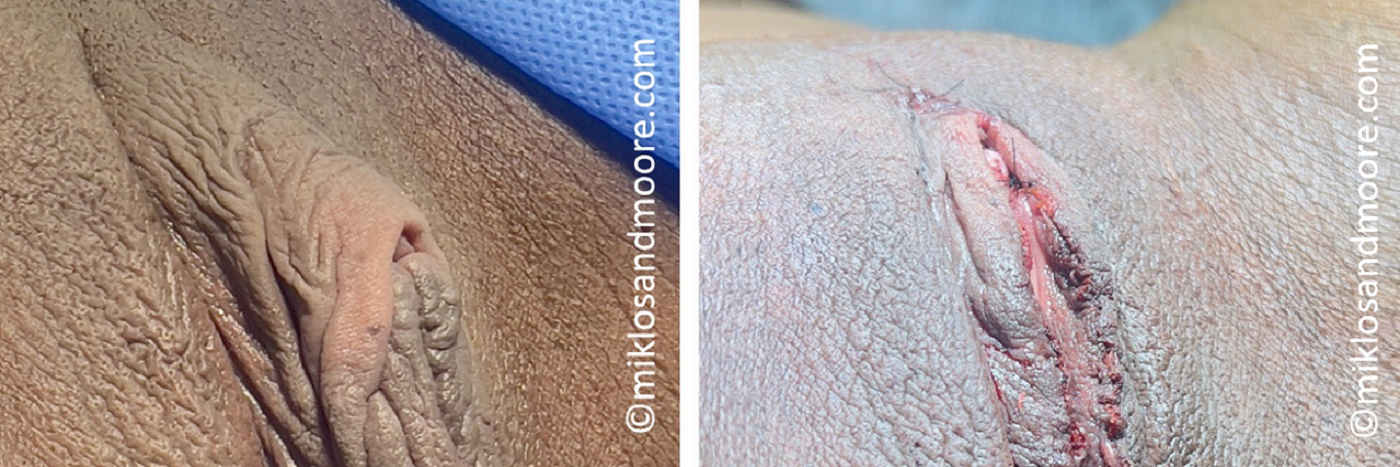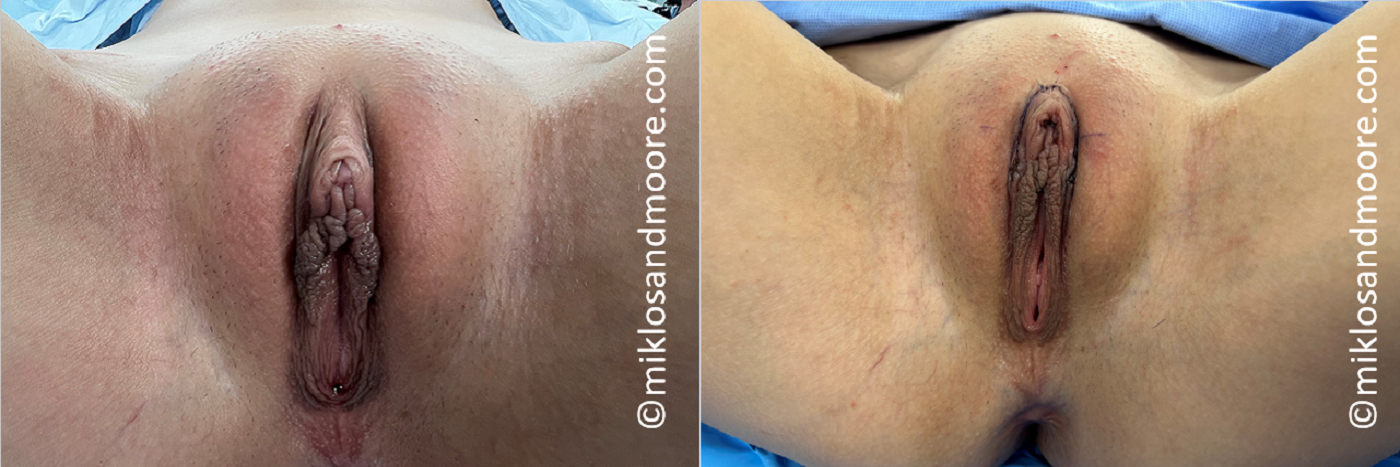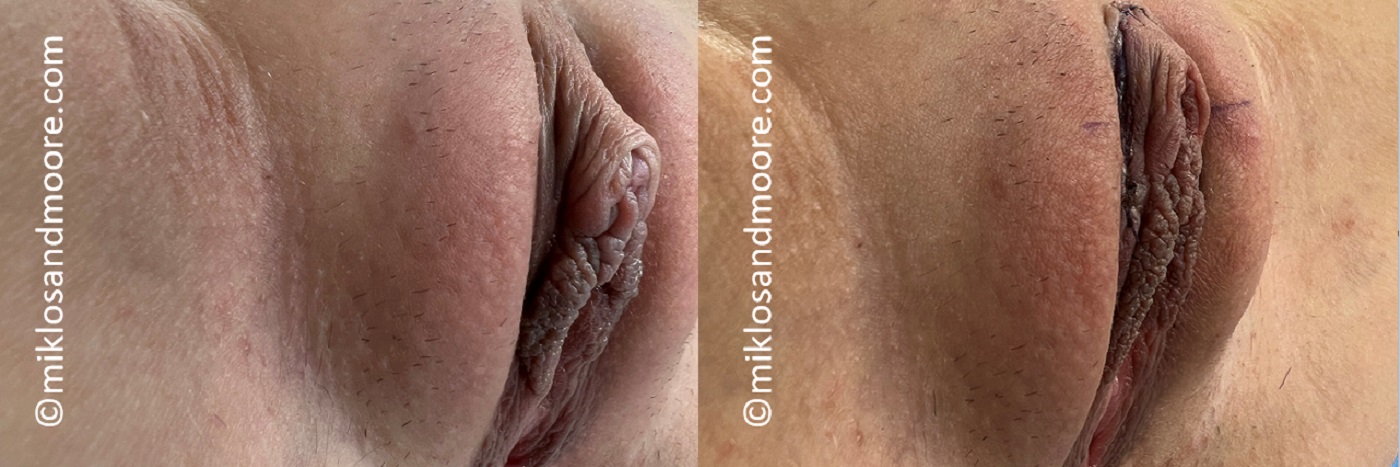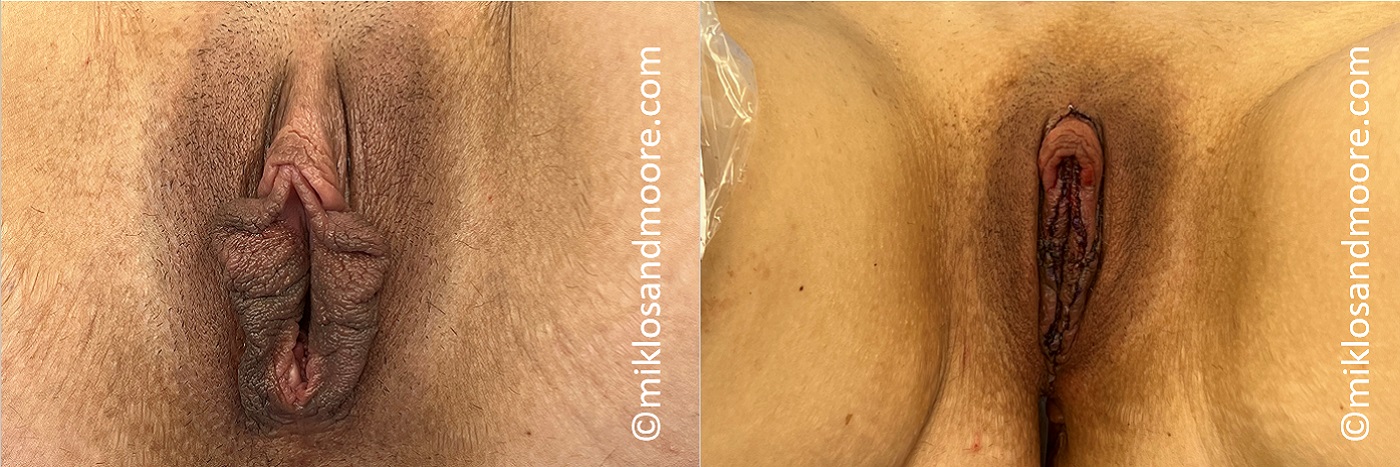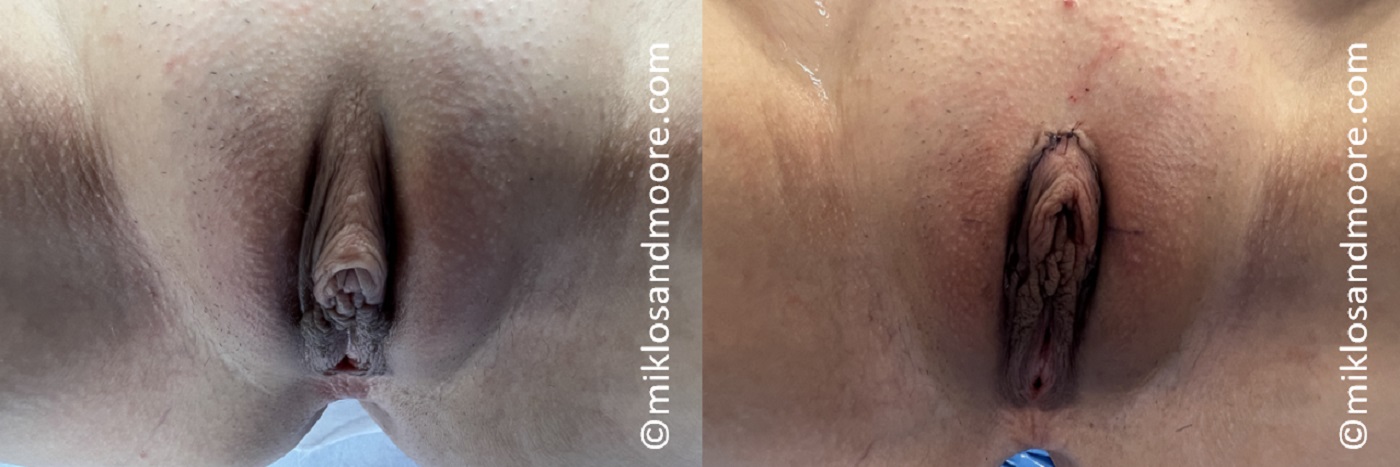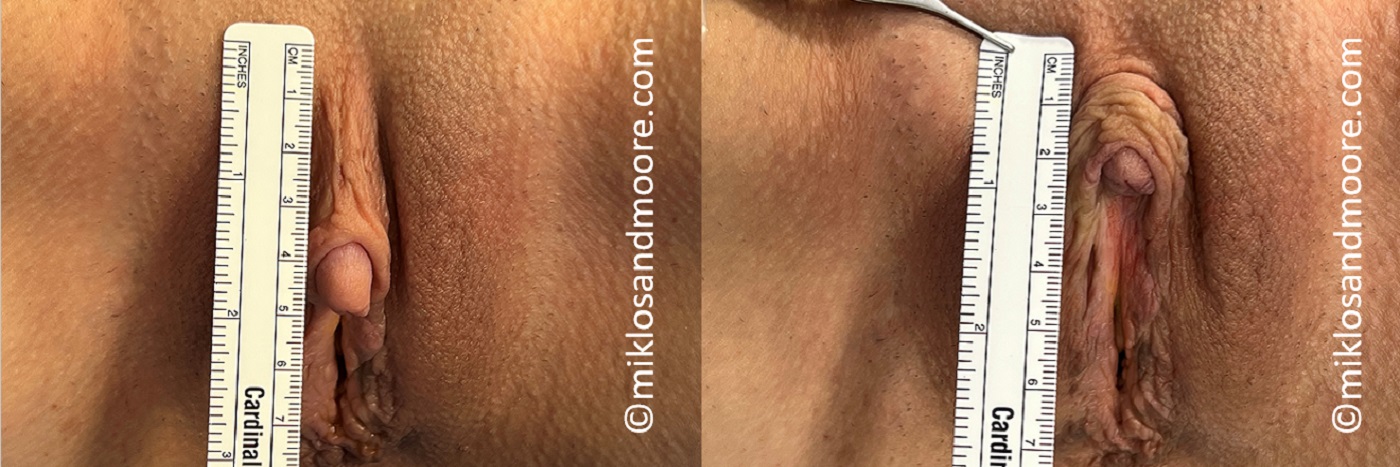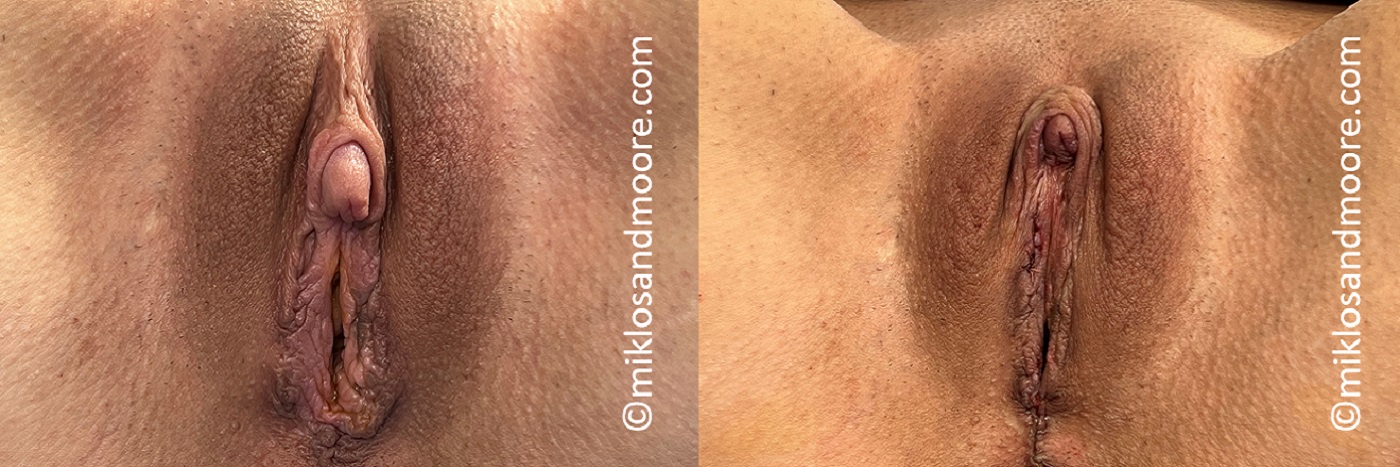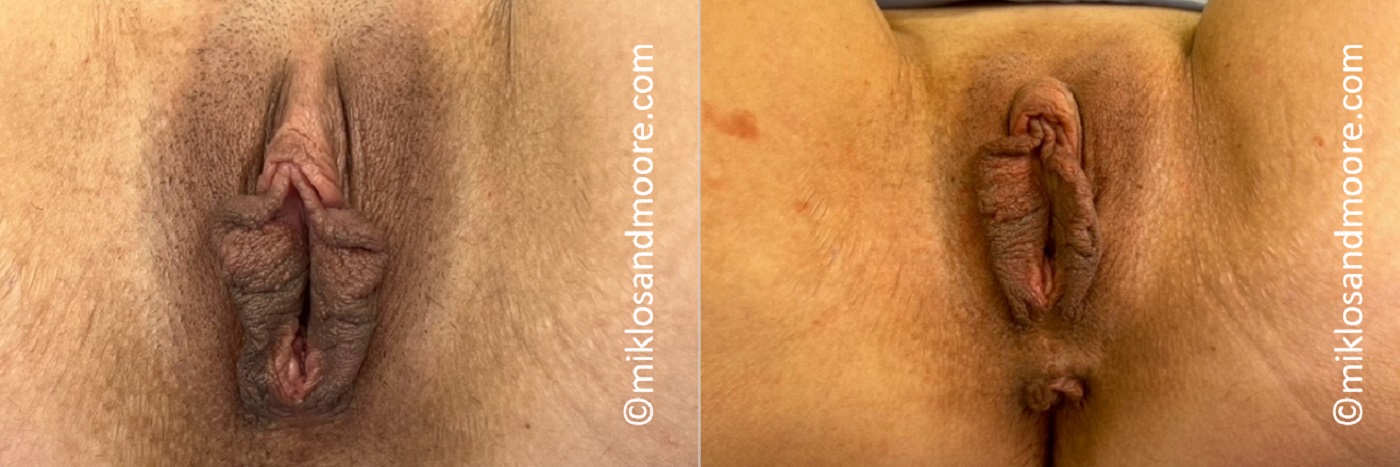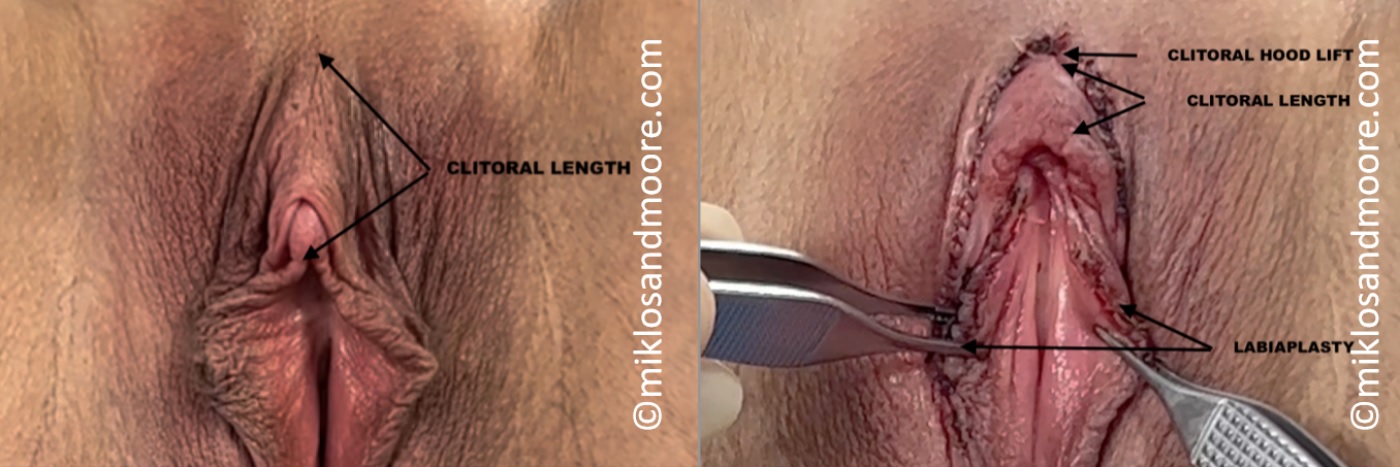CLITOROPEXY
Clitoris Elevation Surgery
Cosmetic vaginal surgery includes clitoropexy or clitoris elevation surgery. Some patients through aging, childbirth, pregnancy, weight gain and loss begin to experience a sagging clitoris. This is usually not a problem unless the woman feels she does not like the appearance of elongated clitoral hood area or even more devastating to some patients is the protrusion outward of the clitoris. Often the clitoris will protrude directly outward with patients often describing the protrusion as a “small penis”. At the patients request the clitoris can be approximated upward and inward to the body lessening the so-called protrusion.
Clitoropexy is most commonly performed with a labiaplasty and clitoral hood lift or clitoral hood reduction. Learn the difference between clitoropexy or clitoroplasty and clitoral hood lift. Clitoropexy is the surgical reduction of an enlarged or protruding clitoris.
WHAT CAUSES CLITOROMEGALY OR CLITORAL ENLARGEMENT?
Clitoromegaly is the technical term for an enlarged clitoris. Patients with an enlarged clitoris usually complain of a protruding clitoris which can be either a functional or an aesthetic issue. Patients with clitoral enlargement are seeking a solution to their drooping clitoris and the solution often requires clitoral surgery in the form of: clitoropexy, clitoroplasty, or clitoral lift. In cases of severe clitoral enlargement some patients require clitoral reduction surgery.
Clitoromegaly can be congenital (present at birth) or acquired (develops later in life) and can be a temporary or permanent condition. Temporary conditions of clitoral enlargement are not abnormal and are not consider true clitoromegaly. Clitoromegaly is defined as an abnormal enlargement of the clitoris which is permanent.
What are temporary conditions that create and enlarged clitoris?
Two primary causes of temporary clitoral enlargement are sexual arousal and vulvitis (vulvar inflammation).
Sexual Arousal – The clitoris is a highly vascular complex structure which is very similar to the penis. During arousal blood fills the clitoris to the point of engorgement and after orgasm or clitoral stimulation cessation the blood flow returns to normal, and the clitoris reverts to its post stimulation size. This is obviously a temporary and normal example of a temporary enlargement.
Vulvitis – or vulva inflammation is a temporary condition usually brought on by:
- Infection
- Friction
- Allergic reaction
Infections can be due to yeast or a sexually transmitted disease. Excessive friction can result from excessive rubbing from clothing or masturbation or a sexual encounter. Allergic reactions most commonly are due to feminine hygiene products, soaps, detergents, lubricants, or moisturizers.
What are the permanent conditions which results in clitoromegaly?
Permanent conditions of clitoromegaly can be broken down into congenital or acquired. Congenital conditions
Congenital clitoromegaly can occur in patients with the following conditions:
- Congenital Adrenal Hyperplasia (CAH)
- Frasier Syndrome
- Disorders of Sexual Development (DSD)
- Donohue Syndrome
- Seckel Syndrome
- Beckwith-Weidman Syndrome
- …. other syndromes without virilization
Acquired Clitoromegaly can occur in patients with:
- Conditions of Endocrine Disorder
- Polycystic Ovarian Syndrome (POS)
- Hyperthecosis
- Anabolic Steroids (testosterone)
- Adrenal Gland Tumors
The most common cause of acquired clitoral enlargement is due to excessive androgen, anabolic steroids, or testosterone. Testosterone is considered a male hormone primarily used to enhance muscular growth, strength, and libido but is naturally found in women but at much lower levels.
Testosterone replacement therapy is a form of hormone replacement therapy for men and women and has become commonplace. Testosterone levels naturally decrease in women as they approach menopause, and these women often suffer from the following:
- Decreased libido (or sexual desire)
- Decreased muscular weakness and fatigue
- Less sexual satisfaction
- Bad mood
Testosterone replacement can alleviate these symptoms quickly and effectively as testosterone replacement is simple and easy. Abuse or overuse of testosterone can result in:
- enlarged clitoris
- extra facial hair
- deeper voice
- acne
- serious health issues that can affect the heart, liver, and kidneys.
WHY DO WOMEN GET A CLITOROPLASTY?
Clitoroplasty surgery is usually performed for two primary reasons:
- Aesthetics – as many patients do not like the appearance of the protruding clitoral glans or elongated shaft of the clitoris. Many patients describe this appearance as a “small penis”
- Discomfort & Hypersensitivity – the protruding clitoris can become irritated and hypersensitive due to rubbing against clothing and undergarments. Some patients describe it as simple irritation and others complain that the excessive rubbing causes the clitoris to be hypersensitive and even painful.
WILL CLITORAL REDUCTION SURGERY REDUCE THESE SYMPTOMS?
By repositioning the clitoris, so it no longer protrudes beyond the labia majora, it will reduce or eliminate the symptoms of irritation, hypersensitivity, and pain in the vast majority of patients.
WILL CLITORIS REDUCTION SURGERY REDUCE OR INCREASE SENSATION OR PLEASURE DURING SEX?
In most patients with hypersensitivity and irritation due to a protruding clitoris, the clitoropexy surgery remedies these problems.
Reducing the clitoral protrusion does not enhance sexual pleasure but woman often report they feel more comfortable and feminine, feel less self-conscious and have an improved self-image. Women with better self-images have been reported to have increased and enhanced sexual experiences.
WHAT ARE THE TREATMENT OPTIONS FOR CLITOROMEGALY?
Treatment options will depend upon the underlying cause of clitoromegaly or clitoral enlargement. Treatment options are usually divided into surgical versus non-surgical options.
Treatment for an allergic reaction
Stop using the insulting product i.e., moisturizer, lubricant or detergent and the local allergic reaction will slowly resolve. Doctors will often offer corticosteroid and antihistamine to help the symptoms of itching and edema.
Treatment for an infection
Depending upon whether the infection is bacterial or fungal your doctor might prescribe an antifungal or antibiotic. These two products will treat the cause of the infection however sometimes corticosteroids or antihistamines will be used to treat the immediate symptoms.
Treatment for Endocrine Disorder (PCOD)
Patient who has a condition like polycystic ovarian syndrome can often be treated with hormone therapy to decrease androgen levels. By reducing the androgen levels the signs and symptoms associated with high testosterone will often regress, as well it is possible the clitoris will shrink in size. Enlarged clitoris that do not respond to hormone therapy may benefit from a surgical procedure to reduce the volume of the clitoris.
Treatment for Congenital Adrenal Hyperplasia (CAH)
Doctors have performed “reduction clitoroplasty” on babies born with CAH to decrease the size of the clitoris, though the practice is considered controversial.
Treatment for Excessive Testosterone (anabolic steroids)
Patients who have elongated or protruding clitoris can often best be surgically treated performing a procedure called a clitoropexy. A “clitoropexy” is a surgical procedure that suspends and repositions the elongated clitoral shaft and glans closer to the pubic bone and further under the clitoral hood. Sometimes Clitoromegaly may also need a “clitoroplasty”, and this is defined as a surgical reduction of the thickness and/or length of the clitoris by removing tissue.
WHAT IS THE DIFFERENCE BETWEEN CLITOROPEXY AND CLITOROPLASTY?
A Clitoropexy is a surgical procedure which lifts the clitoris upward and inward towards pubic bone, it is not just reduction of the clitoral hood like many websites’ states. Clitoropexy elevates and retracts the shaft and the tip of the clitoris reducing the length of the clitoral shaft and elevating the tip of the clitoris i.e., glans. This procedure is best utilized for a protruding and elongated clitoris.
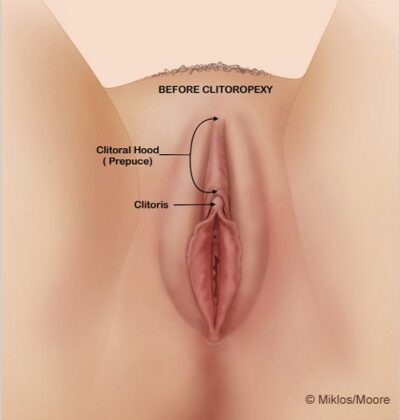
Fig. 1A Before Clitoropexy
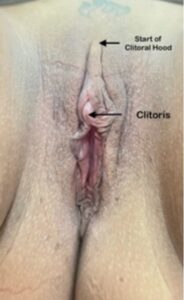
Fig. 1B Before Clitoropexy
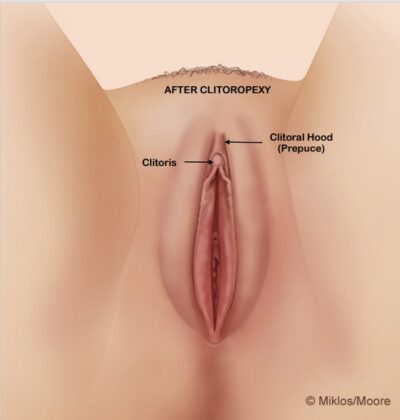
Fig. 2A After Clitoropexy
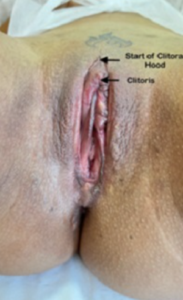
Fig. 2B After Clitoropexy
This suspension procedure shortens the length of the clitoris by putting permanent sutures through suspensory ligament of the clitoris and then through the tough and thickened outer layer of the clitoral body known as fascia and Tunica Albuginea.

The suspensory ligament is the main supporting structure of the clitoris and is comprised of three distinct components which are described as: superficial, intermediate, and deep. When performing a clitoropexy the intermediate and deep component of the suspensory ligament are more durable and robust components and should be utilized for the clitoropexy. Once the suspensory ligament has been secured with a suture then the surgeon’s attention is turned towards the clitoris.
The suture is then passed through the layers of fascia include the Dartos Fascia, Buck Fascia and as well as the Tunica Albuginea. Tunica Albuginea is the tough and thick fibrous layer of tissue that surrounds the Corpora Cavernosa. The suture is placed through the suspensory ligament and then in the body of the clitoris. Note in Figure 6 how far away the sutures are from the dorsal nerves of the clitoris.
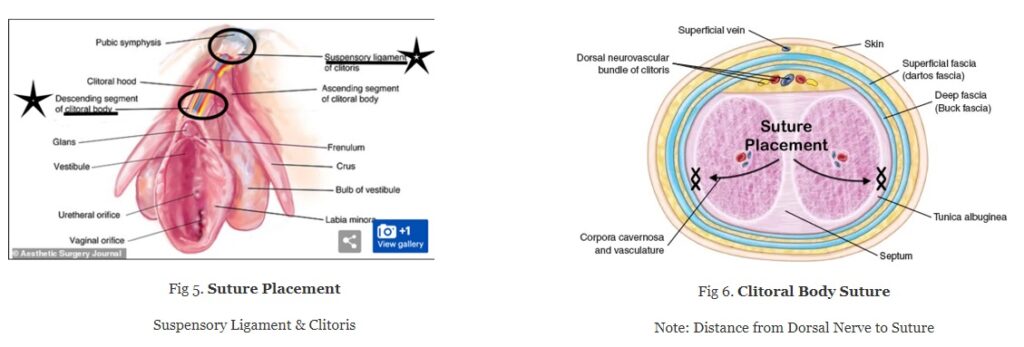
When the suture is tied down it pulls the clitoral shaft and glans inward to the base of the pubic bone. The suspension thus reduces the protruding clitoris. At this point the excess clitoral hood usually requires removal to establish the best aesthetic results. I have been performing clitoropexy procedures for more than 20 years and have yet to hear of a patient complains of decreased clitoral sensitivity as the sutures are not placed in the same area of the dorsal nerves of the clitoris.
“Clitoroplasty” is used to reduce the thickness and or the length of the clitoris by removing or cutting away tissue and this carries a greater risk of injury to the nerve supply of the clitoris. There are many different forms of clitoroplasty procedures including:
- Complete Corpora Canvernosa Excision
- Tunica Albuginea-Sparing Clitoroplasty
- Corporal-Sparing Techniques
It has been my experience that most women with an enlarged clitoris need a clitoropexy which lifts and shortens the clitoris and rarely if ever need the more invasive clitoroplasty which reduces the girth and length by tissue removal.
WHAT IS THE RECOVERY PERIOD AFTER HAVING A CLITOROPEXY?
The recovery period for the clitoropexy procedure is no different than the recovery period for a labiaplasty. Miklos & Moore Urogynecology recommends some reduction and limitation to activities for 6 weeks. The majority of edema or swelling should be gone at that time; however, most patients still have some edema and inflammation for up to 9 months after surgery. During this time the surgical area may feel firm or hard, this will usually soften resolves with time.
HOW DO I CARE FOR THE CLITOROPEXY SURGERY AFTER THE OPERATION?
The patient can use lukewarm water only and antibacterial soap to wash your wound 24-36 hours after the surgery. When taking a shower I recommend no direct application of the shower spray to the surgical area, just allow the water to run down over the area and gently wipe or dab with a washcloth to remove any post-surgical bleeding or betadine.
After urination the process is the same, gently dab or wipe the area as needed. After a shower one can also use a hair dryer to dry the area, avoid getting too close with heated hair dryer as to not burn the patient’s skin.
WHAT PHYSICAL LIMITS DO I HAVE AFTER THE CLITOROPEXY?
Limiting strenuous and sexual activities for a period of 6 weeks is usually most beneficial for patients. Avoid pulling on the area as to not disrupt the sutures. No excessive straining of the pelvic floor such as straining more than that of a bowel movement. Avoid squats and lunges when working out or anything that might cause undo strain on the surgical site. Also avoid straddling anything such as: cycling, spin classes, horses, scooters, and motorcycles.
Avoid sexual intercourse or masturbation for a period of 6 weeks to ensure healing and reduce the inflammation and irritation. The limitations are just based on common sense.
Depending upon the physical demand of your job most patients can return to work within 24 hours. Patients who have a desk job can return to work the next day. The more strenuous jobs will require greater diligence and time before going back to work.
You should avoid the following for four to six weeks to facilitate healing.
- Strenuous exercise.
- Physical activities such as cycling, running, and swimming.
- Sexual intimacy.

